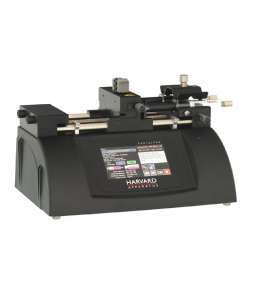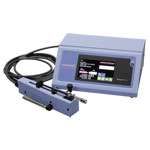Laboratory Fluidics Instruments: The Importance of Innovation
 Instruments for laboratory fluidics include syringe, peristaltic and continuous flow pumps for a wide variety of applications, from mass spectrometry calibration to drug and nutritional studies. In the 21st century, advances in the sciences that involve fluidics are driving the need for more precise observations by laboratory researchers. It is vital, therefore, that these researchers have access to the best and most advanced instrumentation. What kind of instruments are researchers likely to need as they push back the frontiers of the field, and what innovations do recent advances offer them? Some of the most significant innovations have improved the performance of pumps, monitoring and gradient systems, and even syringes.
Instruments for laboratory fluidics include syringe, peristaltic and continuous flow pumps for a wide variety of applications, from mass spectrometry calibration to drug and nutritional studies. In the 21st century, advances in the sciences that involve fluidics are driving the need for more precise observations by laboratory researchers. It is vital, therefore, that these researchers have access to the best and most advanced instrumentation. What kind of instruments are researchers likely to need as they push back the frontiers of the field, and what innovations do recent advances offer them? Some of the most significant innovations have improved the performance of pumps, monitoring and gradient systems, and even syringes.
Precise pumps
Cutting-edge syringe pumps offer innovation in multiple areas, including mass spectroscopy, calibration, drug and nutritional infusions, microdialysis, dispensing, chromatography and LC/HPLC. These pumps can incorporate mechanical drive mechanisms and syringe-holding mechanics to achieve precision to unprecedented levels and across a wide range of flow rates with accuracy within 0.35 percent. Meanwhile, advances in software and user interfaces (e.g. touchscreens) permit easy programming of complex operations at the push of a button. Users can change the flow with time, volume or a triggered event as many times as needed, and inject a drug (or drugs) in a high quantity or all at once. They can also calibrate the flow in concentration units of mg/kg easily so flow is calibrated to concentration of drug weight. In addition to controlling the precise delivery of varying percentages of nutrients or drugs infused, today’s syringe pumps can independently control two liquids, create aerosols for the delivery of coating materials, and support both infusion and withdrawal operations.
 Meanwhile, contemporary peristaltic pumps are ideal for applications over a broad range of flow rates. They are available in compact models for applications that require limited size or weight, low EMI interference, the versatility of single and dual tubes sets and/or external analog control. These instruments come with lithium batteries to protect experiments in the case of power failures. Some models come with pre-programmed flow profiles for constant flow, flow ramps, pulsatile flow and concentration-based fluid delivery. They may come with variable-speed drives with start/stop, speed and direction functions.
Meanwhile, contemporary peristaltic pumps are ideal for applications over a broad range of flow rates. They are available in compact models for applications that require limited size or weight, low EMI interference, the versatility of single and dual tubes sets and/or external analog control. These instruments come with lithium batteries to protect experiments in the case of power failures. Some models come with pre-programmed flow profiles for constant flow, flow ramps, pulsatile flow and concentration-based fluid delivery. They may come with variable-speed drives with start/stop, speed and direction functions.
Separately, pulsatile blood pumps that are now available offer key advantages for those researchers performing cardiovascular and hemodynamic research. They accurately simulate the ventricular action of the heart, featuring silicone rubber-covered heart-type ball valves and smooth flow paths that minimize hemolysis. Only inert materials such as silicone rubber, acrylic plastic and PTFE contact the fluid; the pumping head is easy to take apart and reassemble and can be sterilized. A positive piston actuator and ball check valves provide the proportioning action. Changes in flow rates are prevented regardless of variations in resistance or back pressure.
Modern researchers can choose from among many other pump types depending on the desired application. Centrifugal pumps allow the pumping of blood and/or erythrocyte suspension solutions in the physiological or pharmacological lab. Multichannel pumps are ideal for complex pumping applications such as recirculating organ perfusion systems, and can feature rotors with rollers that provide lower pulsation, higher flow rates or elevated differential pressures. Also available are low EF-noise pumps that deliver high-accuracy, pulseless flow with no electrical noise to interfere with the sensor signal while performing physiological analyses, and glucose clamp pumps enhanced for euglycemic or hyperglycemic studies.
Modern monitoring and gradient systems
Apart from pumps, today’s monitoring and gradient systems incorporate cutting-edge advances as well. For example, remote monitoring systems can report critical data wherever researchers are and whenever they need it, allowing the ability to identify critical variations in conditions when no one is on hand to observe them directly. These can include variations in temperature, humidity levels, intrusion, water seepage, power or HVAC system failure. Once a fault has been detected, such a system can phone, page, fax and/or email an alarm to multiple individuals. The systems also offer customizable voice messages, data radio and cellular communication, data and event logging.
Furthermore, cutting-edge gradient systems allow researchers to quickly and easily run binary and ternary mixtures automatically without a PC. An intuitive program interface makes simple to complex mixing easy. Multiple flow streams can be combined from different pumps into a common output stream; the flow can be smooth and continuous or stepped. It is no longer necessary to stop an experiment, mix different percent volume mixtures and place new syringes into the pumps; now a researcher can push one button and it all happens automatically. This provides a new, economical way to advance experiments and eliminate manual input.
Finally, precision engineering has refined the accuracy of syringes used in tandem with the devices described above. Constant-rate syringes feature spring-driven plungers that allow incremental volumes to be injected with millimeter precision. Other types of syringes can be utilized for air sampling, preparing gas standards and calibration of pneumotachs and spirometers.
This is just a brief survey of some of the innovations linked to instrumentation used in laboratory fluidics research today. Access to the latest innovations associated with these instruments and others will clearly benefit researchers working in these areas, and boost the chances for breakthroughs that will ultimately benefit a wide range of sciences.
Jeffrey A. Duchemin is president and CEO of Harvard Bioscience, a global developer, manufacturer and marketer of a broad range of solutions to advance life science.

